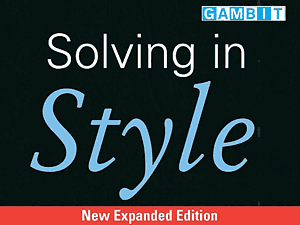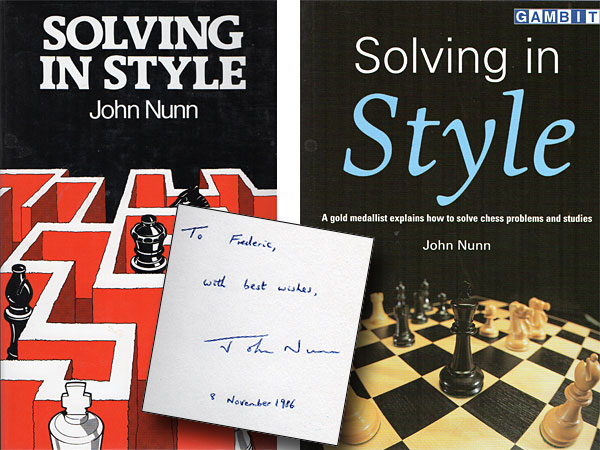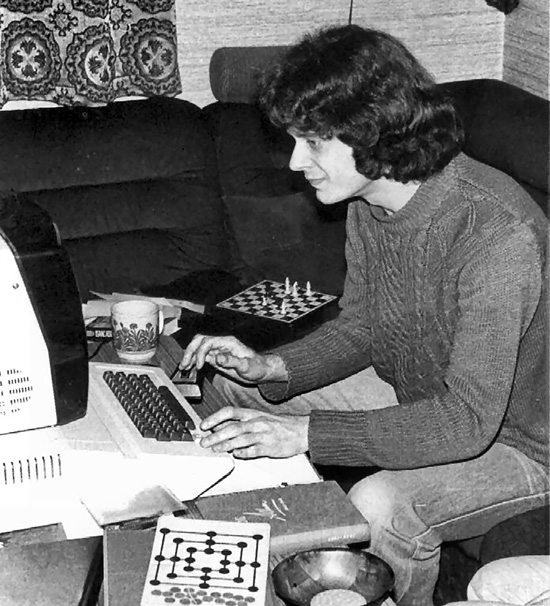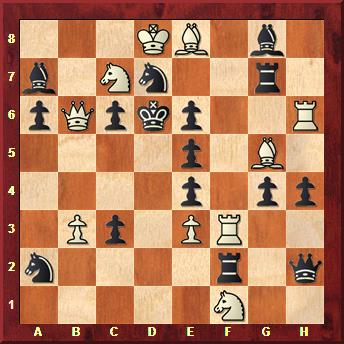



The original 1985 book (left) was given to me in 1986 by the author, and I read it cover to cover, some of the sections multiple times. The book has copious notes by me in pencil, and when I read these today I am drastically reminded how far computers have come: "Impossible for computers" or "This is a line computers simply do not see" are comments that no longer apply. But the pure chess notes attest to the fact that I worked with the book intensively, and learned a great deal about problems and studies from it.

An historical shot of John Nunn in the late 80s composing on an Apple ][
In 2002, the book was reissued unchanged by John’s own company Gambit Publications and is still available in print form. It is identical to the original volume, but my paperback issue contains no notes. I still use the 1985 version when I look things up. Incidentally, our common friend Jon Speelman, who is a linguistically playful creature, around this time called the book Dissolving in Bile, a name that has stuck in my brain ever since.
Recently, John felt that his classic book was in need of an update. In the past 30 years, there has been a massive growth in problem-solving amongst both problemists and over-the-board players, and new problem-solving competitions are springing up on a regular basis. Many readers may participate in such events or be interested in taking part, so he has added an extensive new chapter dealing specifically with problem-solving competitions. There’s certainly no-one better to offer advice on them, as John has won the World Championship three times, the European Championship once and the British Championship eight times.

There is another new chapter of extra problems for readers to solve. These new chapters give very detailed solutions to all the problems, with particular attention being paid to the mental processes which might be used to uncover the solution. That is the extraordinary value the book supplies. There is also a new chapter on proof games, a type of problem which hardly existed at the time of its original publication. These have proved very popular with ChessBase readers, who may recall that one entire Christmas puzzle competition was devoted to them.
Some additional problems have been included in a couple of other chapters, and any problems or studies discovered to be unsound over the past 30 years have been replaced. Overall, there is about 50% more material in this new edition compared to the previous one.
Over the years, the economics of publishing printed books has become far less favourable, with large cost increases hitting several aspects of the publishing process. These days it’s much harder to publish specialised books without giving them a hefty price tag. Fortunately, technology offers an alternative in the shape of electronic publication. Therefore this new edition of Solving in Style appears only in electronic format, with two versions being offered. The first is for the Amazon Kindle and can be read either on a hardware Kindle or using the Kindle software which runs on a wide range of devices, including phones, tablets and computers. This version is an e-book, offering all the text and diagrams in the book and including features such as hyperlinks, but without the ability to play over the moves on-screen.

In Gambit Studio you can tap the notation or use the cursor keys to replay moves (click to enlarge)
The second version is for Gambit Publication’s Chess Studio app, which runs on Apple (iOS) and Android devices (phones and tablets). This version additionally provides the ability to play over all the moves on the screen. Both versions are priced much lower than a printed book would be. Details of how to buy the book are given at the end of the article.
The distinguishing feature of Solving in Style has always been John’s lucid explanations of the problems and how to go about solving them, something readers will probably be familiar with from his many contributions to ChessBase. Here is an extract from the book, a mate in five taken from the 2011 International Solving Contest. It is reproduced with kind permission of the author, and I present it in its original form for you to see how you can follow a chess problem in a book and from a diagram. At the end of the text explanation I will of course give you a JavaScript PGN board to replay the moves.
257 A. Lewandowski and L. Szwedowski, 10th place, 3rd WCCT 1986-8

Mate in five moves
This congested position, using almost the whole chess set, looks very intimidating, but it is fairly straightforward to solve. The first point to notice is that Black has the very strong threat of ...Bxb6, so White’s play must be forcing. Any threats must be checks and must take into account a possible flight at c5 (after the white queen is taken). The BBg8 prevents Rxe6#, while the BRg7 prevents Be7#, so there is a potential Novotny at f7 by either Bf7 or Rf7. Trying these straight away, we discover that 1.Rf7? is met by the Novotny defence 1...Rf6! (not 1...Nf6? 2.Qxc6) and if 2.Rhxf6 then 2...Bxf7 (not 2...Bxb6? due to 3.Rxe6+ Kc5 4.Be7). Now if the white rook on f6 moves away, he again threatens Be7#, but this single threat is easy to counter. It would be different if the rook could move to a square which creates a second threat, but that isn’t possible.
Turning to the second Novonty 1.Bf7?, this is met by 1...Nf6!. Again there is a natural continuation 2.Bxf6 Rxf7 and now if the bishop could move in such a way as to deprive Black of a defensive tempo, White could mate by Rxe6. This last line offers the key to unlock the problem, because if the black queen were not guarding e5, White would have a mate by 3.Bxe5+ Kxe5 4.Rxe6#. So far the WNf1, the most obviously out-of-play piece, hasn’t participated at all, so why not make the key with it: 1.Ng3!. This threatens the immediate mate 2.Nxe4#, and there are actually only two moves to avoid mate in one:
1...hxg3 (now the black queen does not cover e5, so the line given above works) 2.Bf7 (threatening 3.Be7 and 3.Rxe6) 2...Nf6 3.Bxf6 (threatening 4 Be7) 3...Rxf7 (3...Qh4 is an easy to miss sideline, met by 4.Bxh4 followed by Be7 or Rxe6) 4.Bxe5+ Kxe5 5.Rxe6#.
1...Qxg3 2.Rf7 (not surprisingly, White chooses the other Novotny; again the threats are 3.Be7# and 3 Rxe6#) 2...Rf6 3.Rhxf6 Bxf7 (3...Bxb6 4.Rxe6+ Kc5 5.Be7#) 4.Rf1 (this is the crucial difference; f1 has been vacated and the black queen has been deflected and cannot now interpose on d2) with the unstoppable twin threats of 5.Be7# and 5.Rd1#.
Despite the many clues to the solution, only 14 out of 211 solvers scored maximum points on this problem.

[Event "Mate in 5"] [Site "?"] [Date "????.??.??"] [Round "?"] [White "A. Lewandowski & L. Szwedowski"] [Black "?"] [Result "1-0"] [SetUp "1"] [FEN "3KB1b1/b1Nn2r1/pQpkp2R/4p1B1/4p1pp/1Pp1PR2/n4r1q/5N2 w - - 0 1"] [PlyCount "9"] 1. Ng3 $1 (1. Rf7 $2 Rf6 $1) (1. Bf7 $2 Nf6 $1) 1... hxg3 (1... Qxg3 2. Rf7 Rf6 3. Rhxf6 Bxf7 4. Rf1) 2. Bf7 Nf6 3. Bxf6 Rxf7 (3... Qh4 4. Bxh4) 4. Bxe5+ Kxe5 5. Rxe6# 1-0
Note that you can move the pieces on the JavaScript board and even switch on an engine to analyse. Full instructions on the use of our replayer are included in this article.
And now a problem from Solving in Style for our readers to solve. The solution will be given in the second part of my review, which you can expect next week.
286 J. Seilberger, Netherlands West vs East, 1944

Mate in two moves

The Kindle version can be obtained from Amazon in the US ($9.95), UK (£8.09) and Germany (€9.17). The prices may vary slightly according to the tax rates in different countries.
For the app version you should first install the free Gambit Chess Studio app (if you haven’t already done so), on Android devices or for Apple iOS devices. Or you can just search for “Gambit Chess Studio” in the Google Play store or Apple store. Once you have downloaded the app you need to go to the ‘Store’ tab and look in the ‘Recent Gambit books’ folder, where you will find Solving in Style available for purchase at or near the top. The app version costs $9.95, £7.99 or €9.99, again with minor tax variations.